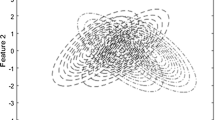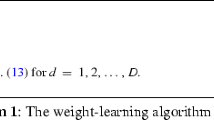Abstract
This paper explores how a kind of probabilistic systems, namely, Gaussian kernel density estimation (GKDE), can be used to interpret several classical kernel methods, including the well-known support vector machine (SVM), support vector regression (SVR), one-class kernel classifier, i.e., support vector data description (SVDD) or equivalently minimal enclosing ball (MEB), and the fuzzy systems (FS). For the SVM, we reveal that the classical SVM with Gaussian density kernel attempts to find a noisy GKDE based Bayesian classifier with equal prior probabilities for each class. For the SVR, the classification based ε-SVR attempts to obtain two noisy GKDEs for each class in the constructed binary classification dataset, and the decision boundary just corresponds to the mapping function of the original regression problem. For the MEB or SVDD, we reveal the equivalence between it and the integrated-squared-errors (ISE) criterion based GKDE and by using this equivalence a MEB based classifier with privacy-preserving function is proposed for one kind of classification tasks where the datasets contain privacy-preserving clouds. For the FS, we show that the GKDE for a regression dataset is equivalent to the construction of a zero-order Takagi–Sugeno–Kang (TSK) fuzzy system based on the same dataset. Our extensive experiments confirm the obtained conclusions and demonstrated the effectiveness of the proposed new machine learning and modeling methods.





Similar content being viewed by others
References
Vapnik V (1995) The nature of statistical learning theory. Springer, New York
Tax D, Duin R (2004) Support vector data description. Mach Learn 54(1):45–66
Tsang IW, Kwok JT, Zurada JM (2006) Generalized core vector machines. IEEE Trans Neural Netw 17(5):1126–1140
Zhou SM, Gan JQ (2007) Constructing L2-SVM-based fuzzy classifiers in high-dimensional space with automatic model selection and fuzzy rule ranking. IEEE Trans Fuzzy Syst 15(3):398–409
Juang CF, Hsieh CD (2009) TS-fuzzy system-based support vector regression. Fuzzy Sets Syst 160:2486–2504
Chiang JH, Hao PY (2004) Support vector learning mechanism for fuzzy rule-based modeling: a new approach. IEEE Trans Fuzzy Syst 12(1):1–11
Chen Y, Wang JZ (2003) Support vector learning for fuzzy rule-based classification systems. IEEE Trans Fuzzy Syst 11(6):716–728
Kwok JT, Tsang IW (2003) Linear dependency between epsilon and the input noise in epsilon-support vector regression. IEEE Trans Neural Netw 14(3):544–553
Gan MT, Hanmandlu M, Tan AH (2005) From a Gaussian mixture model to additive fuzzy systems. IEEE Trans Fuzzy Syst 13(3):303–316
Verma N, Hanmandlu M (2007) From a Gaussian mixture model to non-additive fuzzy systems. IEEE Trans Fuzzy Syst 15(5):809–826
Kim J, Scott CD (2010) L2 kernel classification. IEEE Trans Pattern Anal Mach Intell 32(10):1822–1831
Girolami M, He C (2003) Probability density estimation from optimally condensed data samples. IEEE Trans Pattern Anal Mach Intell 25(10):1253–1264
Deng ZH, Chung FL, Wang ST (2008) FRSDE: fast reduced set density estimator using minimal enclosing ball approximation. Pattern Recogn 41(4):1363–1372
Chen G, Hong X, Harris CJ (2010) Probability density estimation with tunable kernels using orthogonal forward regression. IEEE Trans Syst Man Cybern (Part B) 40(4):1101–1114
Orchel M (2011) Regression based on support vector classification. http://svms.pl/SVM/Files/svcRegression_Orchel.pdf
Tao Q, Cao JD, Sun DM (2002) A regression method based on the support vectors for classification. J Softw 13(5):1024–1028
Chen K, Liu L (2005) Privacy preserving data classification with rotation perturbation. In: Proceedings of IEEE ICDM’05, pp 589–592
Vaidya J, Yu H, Jiang X (2008) Privacy preserving SVM classification. Knowl Inform Syst 14(2):161–178
Lanckriet GRG, Ghaoui LE, Bhattacharyya C, Jordan MI (2003) A robust minimax approach to classification. J Mach Learn Res 3:555–582
Stefan R (2010) SVM Classifier Estimation from Group Probabilities. In: Proceedings of the 27th international conference on machine learning (ICML 2010), Haifa, Israel
Quadrianto N, Smola AJ, Caetano TS, Le QV (2009) Estimating labels from label proportions. J Mach Learn Res 10:2349–2374
Zhang ZC, Chung FL, Wang ST (2012) Collaborative classification mechanism for privacy-preserving on horizontally full-partitioned data. IEEE Trans SMC (Part B) (submitted)
Chung FL, Wang ST, Deng ZG, Hu DW (2004) Fuzzy Kernel Hyperball Perceptron. Appl Soft Comput 5:67–74
Jang JSR, Sun CT, Mizutani E (1997) Neuro-fuzzy and soft-computing. Prentice-Hall, Upper Saddle River
Schölkopf B, Smola AJ, Williamson RC, Bartlett PL (2000) New support vector algorithms. Neural Comput 12(5):1207–1245
Chung FL, Deng ZH, Wang ST (2009) From minimum enclosing ball to fast fuzzy inference system training on large datasets. IEEE Trans Fuzzy Syst 17(1):173–184
Chen CY, Zhang JP, He XF, Zhou ZH (2011) Non-parametric Kernel learning with robust pairwise constraints. Int J Mach Learn Cybern. doi:10.1007/s13042-011-0048-6
He Q, Wu CX (2011) Separating theorem of samples in Banach space for support vector machine learning. Int J Mach Learn Cybern 2(1):49–54
Liu Z, Wu QH, Zhang Y, Chen CL (2011) Adaptive least squares support vector machines filter for hand tremor canceling in microsurgery. Int J Mach Learn Cybern 2(1):37–47
Wu J, Wang ST, Chung FL (2011) Positive and negative fuzzy rule system, extreme learning machine and image classification. Int J Mach Learn Cybern 2(4):261–271
Wang LJ (2011) An improved multiple fuzzy NNC system based on mutual information and fuzzy integral. Int J Mach Learn Cybern 2(1):25–36
Acknowledgments
This work was supported in part by the Hong Kong Polytechnic University under Grants 1-ZV5V and G-U724, and by the National Natural Science Foundation of China under Grants 60903100, 60975027, 61170122, and by the Natural Science Foundation of Jiangsu Province under Grant BK2009067, 2011NSFJS plus its Key Grant, JiangSu 333 expert engineering grant (BRA2011142), and 2011 Postgraduate Student’s Creative Research Fund of Jiangsu Province under Grant CXZZ11-0483.
Author information
Authors and Affiliations
Corresponding author
Rights and permissions
About this article
Cite this article
Wang, S., Deng, Z., Chung, Fl. et al. From Gaussian kernel density estimation to kernel methods. Int. J. Mach. Learn. & Cyber. 4, 119–137 (2013). https://doi.org/10.1007/s13042-012-0078-8
Received:
Accepted:
Published:
Issue Date:
DOI: https://doi.org/10.1007/s13042-012-0078-8




